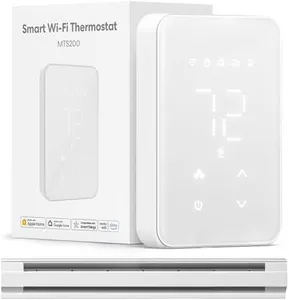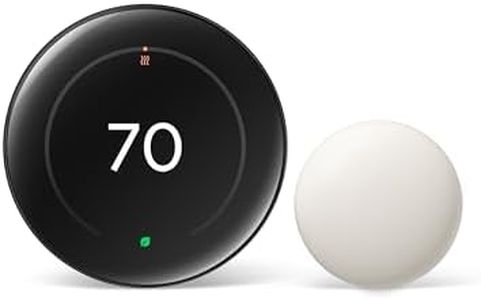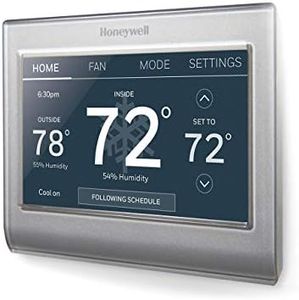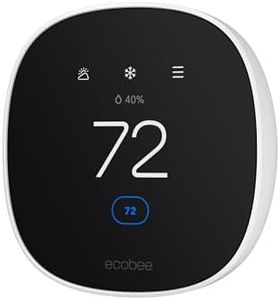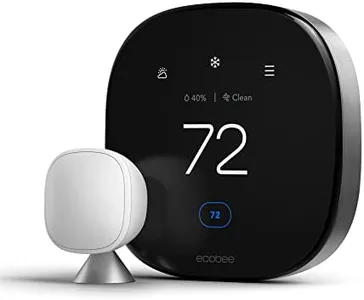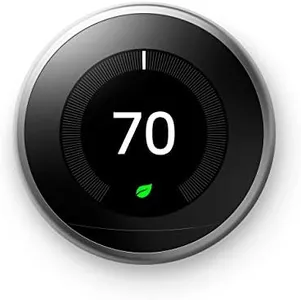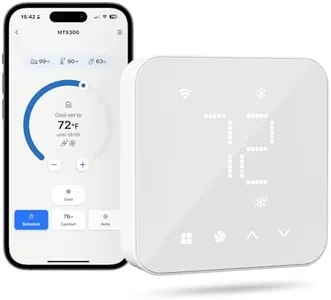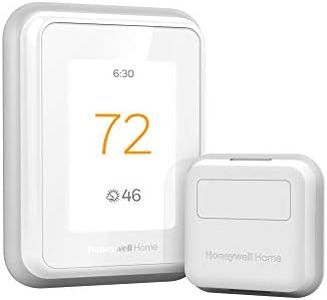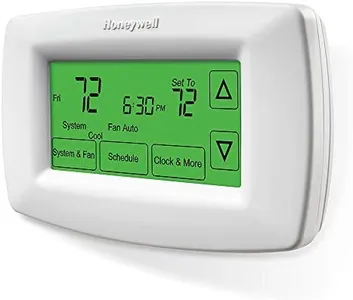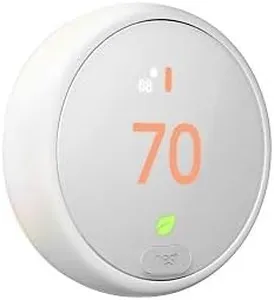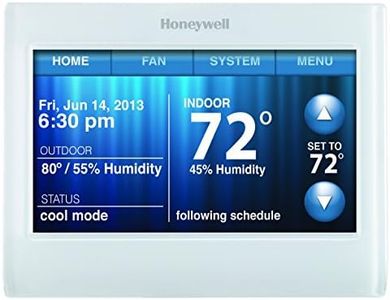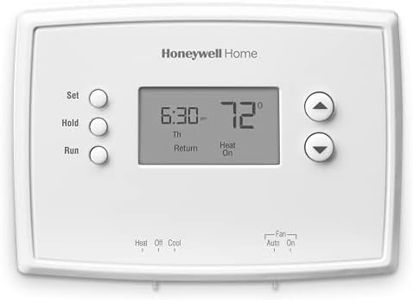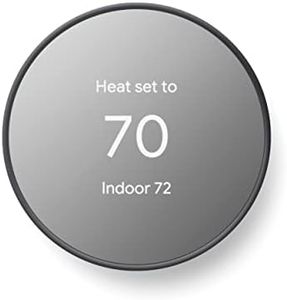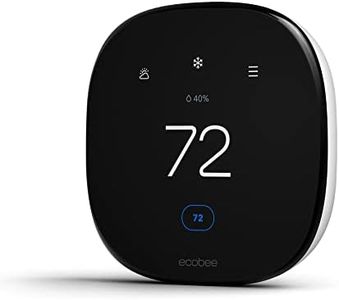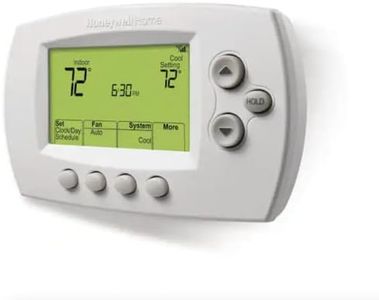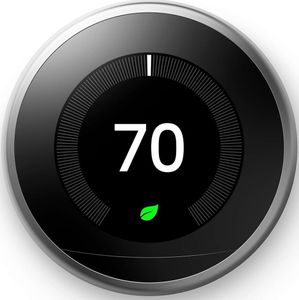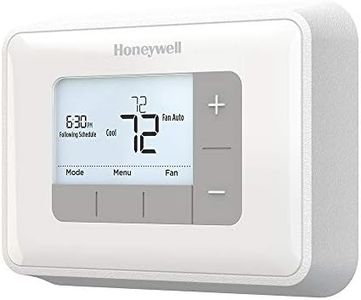10 Best Thermostats 2025 in the United States
Our technology thoroughly searches through the online shopping world, reviewing hundreds of sites. We then process and analyze this information, updating in real-time to bring you the latest top-rated products. This way, you always get the best and most current options available.

Our Top Picks
Winner
Google Nest Learning Thermostat (4th Gen, 2024) with Nest Temperature Sensor - Energy Saving Smart Thermostat with Adaptive Eco - Works with Alexa and Google Home App - Polished Obsidian
Most important from
723 reviews
The Google Nest Learning Thermostat (4th Gen, 2024) is a smart, energy-saving device that can bring both convenience and efficiency to your home. One of its top strengths is compatibility; it works with most 24V systems common in households, including gas, electric, and heat pump systems, and generally doesn't require complex wiring. This makes it accessible for many users. Installation is relatively straightforward, typically taking around 40 minutes, which is a plus for those who prefer DIY projects. The included Nest Temperature Sensor helps manage hot and cold spots, ensuring that every room can be comfortable, and it integrates well with the Google Home app for easy control and monitoring.
Its smart features are impressive; the device can learn your preferred temperatures and schedules, suggesting energy-saving adjustments you can approve through the app. It also works with Amazon Alexa, allowing for voice control, adding a layer of convenience. Energy savings are another big advantage, with an estimated reduction of 12% on heating and 15% on cooling bills. This makes it a particularly good choice for budget-conscious and eco-friendly users. The user interface is sleek and modern, featuring a polished obsidian finish and a large, easy-to-read display that adjusts brightness automatically or can be manually controlled.
However, there are a few drawbacks. The initial cost might be high for some, and while installation is generally easy, those with less common heating and cooling systems might find it more challenging. Additionally, the reliance on a stable Wi-Fi connection for smart features could be a limitation in areas with poor internet connectivity. In summary, the Google Nest Learning Thermostat (4th Gen) is ideal for those looking for an advanced, user-friendly smart thermostat that offers significant energy savings and broad compatibility.
Most important from
723 reviews
Honeywell Home RTH9585WF Wi-Fi Smart Color Thermostat, 7 Day Programmable, Touch Screen, Energy Star, Alexa Ready, C-Wire Required, Not Compatible with Line Volt Heating Gray
Most important from
18766 reviews
The Honeywell Home RTH9585WF1004 Wi-Fi Smart Color Thermostat is a strong contender in the smart thermostat category, particularly for those looking for versatility and convenience. Its compatibility with major smart home systems like Alexa, Google Home, and SmartThings allows for seamless integration into your existing setup. The customizable color touchscreen is a standout feature, making it visually appealing and easy to navigate. Users can easily adjust settings and view important information like local weather and indoor humidity levels at a glance.
Programmability is another key strength; it offers flexible scheduling options that can be tailored to your daily routine or adjusted based on energy pricing. This can lead to notable energy savings, a crucial aspect for budget-conscious consumers mindful of their environmental impact. The intelligent alerts for maintenance reminders, such as air filter changes, enhance user experience by keeping you informed about your system's health.
However, there are a few points to consider. While installation is generally straightforward, some users may find it a bit challenging if they lack experience with home wiring or HVAC systems. Additionally, being a Wi-Fi thermostat, it relies on a stable internet connection to utilize its smart features fully. Any connectivity issues could hinder performance, especially when you're counting on alerts or remote access.
The price point may be higher than traditional thermostats, which could deter budget-conscious buyers who aren't interested in smart features. Nevertheless, those who appreciate advanced capabilities and energy management will likely find the investment worthwhile. The Honeywell Home RTH9585WF1004 is best suited for homeowners or small businesses looking to enhance their heating and cooling systems with modern technology and energy efficiency.
Most important from
18766 reviews
New 2025 ecobee Smart Thermostat Essential - Energy Star Certified programmable Wi-Fi Thermostat - Works with Siri, Alexa, and Google Assistant
Most important from
80 reviews
The 2025 ecobee Smart Thermostat Essential is a robust choice for anyone looking to modernize their home heating and cooling systems. One of its standout features is the potential to save up to 23% on energy costs annually, which can translate to approximately $250 in savings each year, making it a cost-effective option. Its compatibility is impressive, working with 85% of HVAC systems, and it integrates seamlessly with major smart home ecosystems like Apple HomeKit, Google Assistant, and Amazon Alexa. This makes it a versatile choice for various home setups.
The thermostat is easy to control via its color touchscreen or the highly-rated ecobee app, which also provides software updates to keep the device running optimally over time. Its auto-scheduling and auto-away modes help in optimizing energy use by adjusting temperatures based on your presence. For homes without a common wire (C-Wire), the installation is simplified with the optional Power Extender Kit, although this is an additional purchase.
The inclusion of smart features such as indoor humidity detection and energy use optimization during off-peak hours adds to the device's appeal. Additionally, the ability to add SmartSensors for monitoring different rooms can further enhance comfort and energy savings. However, some users might find the need for purchasing additional components like the Power Extender Kit and SmartSensors an extra cost and effort. The device's minimalist design and the clear LCD display make it user-friendly, although users should ensure their system's compatibility using the ecobee Compatibility Checker before purchase.
Most important from
80 reviews
Buying Guide for the Best Thermostats
Choosing the right thermostat for your home can significantly impact your comfort and energy efficiency. A thermostat regulates the temperature of your home by controlling your heating and cooling systems. When selecting a thermostat, it's important to consider your specific needs, the compatibility with your HVAC system, and the features that will provide the most convenience and efficiency for your lifestyle.FAQ
Most Popular Categories Right Now
